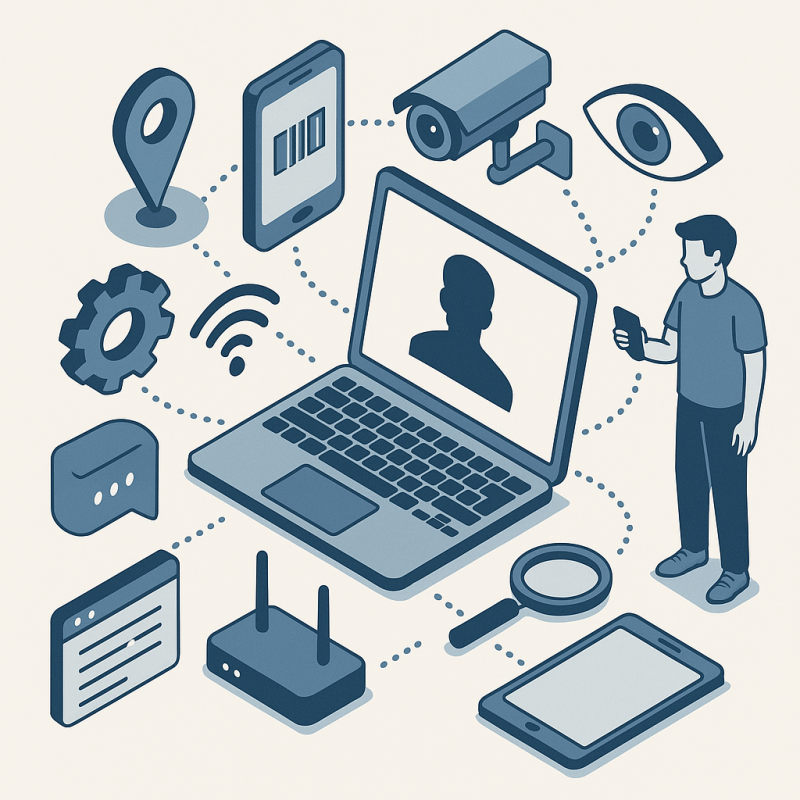Table of Contents Show
Most people know they’re being watched online – but few realize just how deep that rabbit hole goes. Big Tech companies – Google, Meta (Facebook and Instagram), Amazon, Apple, Microsoft, and others – collect massive amounts of information about us every single day. We’re not just talking about our names and email addresses. We’re talking about a detailed digital profile: where you go, who you talk to, what you buy, how often you scroll Instagram, when you sleep, and what your voice sounds like when you’re talking to your smart speaker at 2 AM.
It’s the price we pay for “free” services. But that price is no longer hidden. It’s now in plain sight – and it’s costing us our privacy.
This article digs into what Big Tech really knows about you and, more importantly, how to stop feeding them your life story.
What Data Do Big Tech Companies Collect?
Here’s a breakdown of the core types of data Big Tech companies collect – and some you might not even expect:
1. Personal Information
At the most basic level, they know your:
- Full name
- Date of birth
- Email address
- Phone number
- Home address
- Payment details (if you’ve ever shopped online)
- Education and employment info (especially via LinkedIn or Google account profiles)
Even if you never typed these things in manually, they might still know. For example, Gmail scans your messages to extract relevant details for autofill and advertising. Amazon knows who you’re sending gifts to. Facebook can piece together your birthdate based on when people post on your wall.
2. Location Data
If you use a smartphone, carry a smartwatch, or use GPS in your car, your location is constantly being logged. Companies gather:
- Real-time GPS data
- Historical location tracking (e.g., Google Maps Timeline)
- Wi-Fi and Bluetooth proximity (nearby devices and networks)
- IP address-based locations
- Geotags on photos and videos
Google alone can track your entire movement history down to the minute, including whether you walked, drove, or biked. Check your timeline in Google Maps – it’s equal parts fascinating and terrifying.
3. Browsing History
Every click, search, and visit tells a story. Big Tech collects:
- Websites you visit
- Search queries (Google, Bing, YouTube, Amazon)
- Clicked ads
- Dwell time on pages
- Links you share or bookmark
- Shopping behavior
This data helps shape your online experience – and the ads that follow you around like a digital shadow.
4. Device Information
Whenever you log in, Big Tech logs info about your hardware, including:
- Device model
- Operating system
- Battery level
- Screen resolution
- Unique device ID
- Whether the device is rooted/jailbroken
- Installed apps
Some platforms even track how fast you type, the angle you’re holding your phone at, and how hard you press the screen. Creepy? Yes. Useful for them? Absolutely.
5. App and Service Usage
Big Tech doesn’t stop at the device – they dive into your app usage:
- Which apps you open and when
- What features you use (e.g., Stories vs. Posts)
- How long you spend in each app
- In-app purchases
- Interaction with notifications
This helps them optimize apps, keep you engaged longer, and push features you didn’t ask for.
6. Communication Data
If you use services like Gmail, Facebook Messenger, WhatsApp, or even Alexa, Big Tech potentially has access to:
- Email subject lines and metadata
- Message timestamps
- Call logs and duration
- Voice recordings (like with Alexa, Siri, or Google Assistant)
- Shared media (photos, files)
Even if they’re not directly reading your messages due to encryption, they may still analyze metadata and behavioral patterns.
7. Biometric and Behavioral Data
This is the futuristic stuff:
- Fingerprints and facial recognition (for unlocking phones or ID verification)
- Typing speed
- Mouse movements
- Gait (how you walk, from smartwatch sensors)
- Voice recognition and tone
- Sleep and heart rate data from wearables
Combine this with AI, and they can build a startlingly accurate picture of who you are, how you feel, and what you might do next.
How Is All This Data Used?
Here’s how companies justify collecting your personal information:
1. Personalized Advertising
This is the goldmine. Targeted ads are far more valuable than generic ones. By knowing your behavior, interests, and preferences, companies can sell ad space at a premium to advertisers wanting to reach you specifically.
This is why you Google “flights to Italy” once and get bombarded with Italian hotel ads for a week.
2. Product Development and Optimization
Companies use user data to improve apps, websites, hardware, and AI services. Every time you abandon a cart, rage-quit an app, or scroll past a feature, they’re learning from it.
Example: If a million users uninstall an app within 24 hours, developers know something’s broken – or irritating.
3. AI Training
User data is fed into machine learning algorithms to improve speech recognition, predictive text, image recognition, and more. When you use Google Translate or ask Alexa a question, you’re helping train it, whether you realize it or not.
4. Data Sharing with Third Parties
This is where things get fuzzy. Some companies share or sell anonymized (or semi-anonymized) data to advertisers, researchers, affiliates, and other entities.
This opens the door to potential abuse. Even anonymized data can often be re-identified with enough cross-referencing.
5. Risk Assessment and Security
To detect fraud, prevent spam, or secure accounts, companies analyze behavioral data. Sudden logins from a new country? Login attempts at 3 a.m.? They’ll flag that. While useful, it still adds to the profile being built.
6. Government Surveillance Requests
Under laws like the USA PATRIOT Act or Europe’s GDPR provisions (under warrant), tech companies can and do hand over data to authorities. Sometimes this includes metadata, messages, or stored content.
Real-World Examples of What They Know
Here are some infamous cases that show just how deep the data rabbit hole goes:
| Case | What Happened | Takeaway |
|---|---|---|
| Cambridge Analytica | Facebook data from 87 million users was harvested and used for political manipulation. | Even quiz apps can extract your friends’ data. |
| Google’s Location Tracking | A 2018 AP investigation revealed Google tracks your location even when “Location History” is off. | Disabling settings isn’t always enough. |
| Amazon Alexa Eavesdropping | In 2019, it was revealed Amazon workers listen to Alexa recordings to “improve the service.” | Voice data can be stored and reviewed manually. |
| TikTok Data Scrutiny | The app has faced criticism for collecting keystroke patterns, clipboard data, and biometric identifiers. | New platforms may be even more invasive. |
How to Limit the Data Big Tech Collects
The bad news: You’ll never be 100% private if you use modern technology.
The good news: You can significantly reduce your data footprint.
Let’s break it down:
1. Review Privacy Settings
Every platform has privacy settings – most are buried under confusing menus.
- On Google, go to My Activity to view and delete your search, YouTube, and location history.
- On Facebook, go to Settings > Privacy > Your Facebook Information to manage what’s stored.
- On Apple, check Settings > Privacy & Security for app permissions.
- On Amazon, go to Your Account > Communication and Content to manage Alexa recordings.
Do a regular privacy audit. Once every few months is ideal.
2. Use Privacy-Focused Tools
Here’s your new digital toolbox:
| Need | Privacy-Friendly Alternative |
|---|---|
| Search engine | DuckDuckGo, Startpage |
| Browser | Brave, Firefox with privacy add-ons |
| ProtonMail, Tutanota | |
| Messaging | Signal, Telegram |
| Cloud storage | Sync.com, pCloud (with encryption) |
| Maps | Organic Maps, Here WeGo |
| VPN | Mullvad, ProtonVPN, NordVPN |
You don’t have to abandon Big Tech completely – just reduce reliance.
3. Limit Location Sharing
Your phone shares your location constantly. You can stop this:
- Turn off Location Services unless needed.
- Set apps to “While Using” instead of “Always.”
- Disable Google’s Web & App Activity, which often includes location history.
- Use Airplane Mode when commuting or walking around town.
If a flashlight app wants your GPS, something shady is going on.
4. Block Tracking Cookies
Tracking cookies follow you around the web.
- Use extensions like uBlock Origin, Privacy Badger, and Ghostery.
- Enable “Do Not Track” in your browser (though not all sites honor it).
- Consider browser-level features like Firefox’s Enhanced Tracking Protection.
Also, clear your cookies and cache weekly.
5. Opt Out of Ad Personalization
Most big platforms let you do this – if you dig deep enough.
- Google: https://adssettings.google.com
- Facebook: Settings > Ads > Ad Settings
- Amazon: Advertising Preferences
- Apple: Disable Personalized Ads in Settings > Privacy & Security > Apple Advertising
You’ll still see ads – but they won’t be quite as creepy.
6. Revoke App Permissions
Apps often ask for more access than they need.
Do a regular app audit. Ask:
- Why does this calculator need camera access?
- Does my weather app need my exact location?
- Do I really need Facebook Messenger?
Delete apps you don’t use. Revoke permissions you don’t understand.
7. Avoid Logging In with Google or Facebook
When you sign into websites using “Sign in with Google,” you’re allowing third parties access to your profile.
It’s convenient – but comes at the cost of privacy.
Instead, create a separate login or use an anonymous email alias (like from SimpleLogin).
8. Turn Off Voice Assistants
Alexa, Siri, and Google Assistant constantly listen for their wake words – but they’ve been known to misfire and record accidentally.
Disable voice assistants entirely if you don’t use them. You can also delete stored recordings from their dashboards:
- Alexa: https://www.amazon.com/alexaprivacy
- Google: https://myactivity.google.com/voiceaudio
- Siri: Settings > Siri & Search > Siri History
9. Use a VPN and Encrypted Messaging
A VPN (Virtual Private Network) masks your IP address and encrypts your traffic. Encrypted messaging apps protect your chats from snooping.
- VPNs are useful for browsing, torrenting, and accessing content.
- Messaging apps like Signal and Telegram offer end-to-end encryption by default.
Just avoid free VPNs – they’re often worse than not using one.
10. Practice Minimalism
This might be the most powerful advice: Use fewer services.
Do you really need:
- A smart toaster?
- Three fitness apps?
- Ten email accounts?
Every app, device, and service is another data faucet. Unplug what you can.
A Final Reality Check
Yes, data collection is invasive. And yes, it’s hard to avoid.
But remember this: You don’t need to go full tinfoil hat to take back some control.
Start small:
- Change your search engine.
- Turn off unnecessary permissions.
- Audit your digital footprint once a month.
The more people push back – by demanding privacy, using alternatives, and refusing to play the data-harvesting game – the more Big Tech will have to listen.
Useful Resources
Here are two further deep dives into this topic from reputable sources:
- Mozilla’s Privacy Not Included Guide – A fantastic tool that evaluates the privacy of smart gadgets and apps.
- EFF’s Surveillance Self-Defense Guide – A must-read for anyone serious about protecting their digital privacy.









